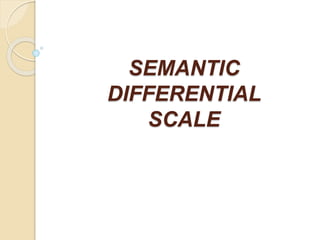
Semantic differential
- 2. Semantic differential scale or the S.D. scale developed by Charles E. Osgood, G.J. Suci and P.H. Tannenbaum (1957), is an attempt to measure the psychological meanings of an object to an individual. This scale is based on the presumption that an object can have different dimensions of connotative meanings which can be located in multidimensional property space, or what can be called the semantic space in the context of S.D. scale.
- 3. This scaling consists of a set of bipolar rating scales, usually of 7 points, by which one or more respondents rate one or more concepts on each scale item.
- 4. For instance, the S.D. scale items for analysing candidates for leadership position may be shown as under: (E ) Successful (P ) Severe (P ) Heavy (A ) Hot (E ) Progressive (P ) Strong (A ) Active (A ) Fast (E ) True (E ) Sociable Unsuccessful Lenient Light Cold Regressive Weak Passive Slow False Unsociable 3 2 1 0 –1 –2 –3
- 5. Candidates for leadership position (along with the concept—the ‘ideal’ candidate) may be compared and we may score them from +3 to –3 on the basis of the above stated scales. (The letters, E, P, A showing the relevant factor viz., evaluation, potency and activity respectively, written along the left side are not written in actual scale. Similarly the numeric values shown are also not written in actual scale.)
- 6. Osgood and others did produce a list of some adjective pairs for attitude research purposes and concluded that semantic space is multidimensional rather than unidimensional. They made sincere efforts and ultimately found that three factors, viz., evaluation, potency and activity, contributed most to meaningful judgements by respondents. The evaluation dimension generally accounts for 1/2 and 3/4 of the extractable variance and the other two factors account for the balance
- 7. Procedure : - Various steps involved in developing S.D. Scale are as follows : First of all the concepts to be studied are selected. The concepts are usually chosen by personal judgement, keeping in view the nature of the problem. The next step is to select the scales bearing in mind the criterion of factor composition and the criterion of scale’s relevance to the concepts being judged (it is common practice to use at least three scales for each factor with the help of which an average factor score has to be worked out). One more criterion to be kept in view is that scales should be stable across subjects and concepts.
- 8. Then a panel of judges are used to rate the various stimuli (or objects) on the various selected scales and the responses of all judges would then be combined to determine the composite scaling.
- 9. THANK YOU